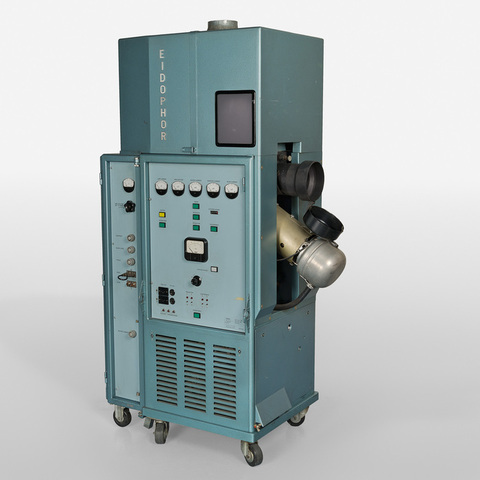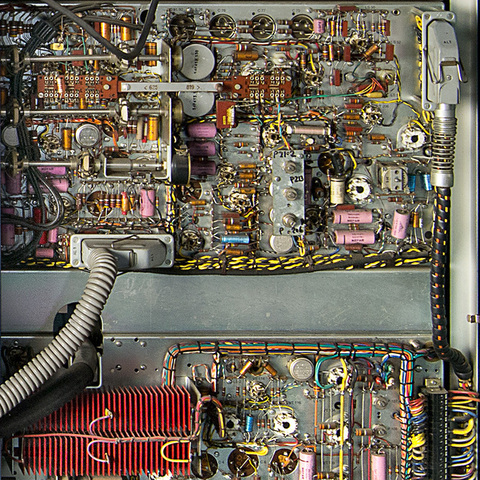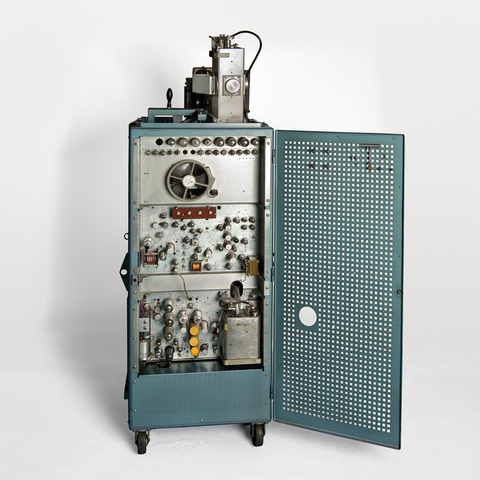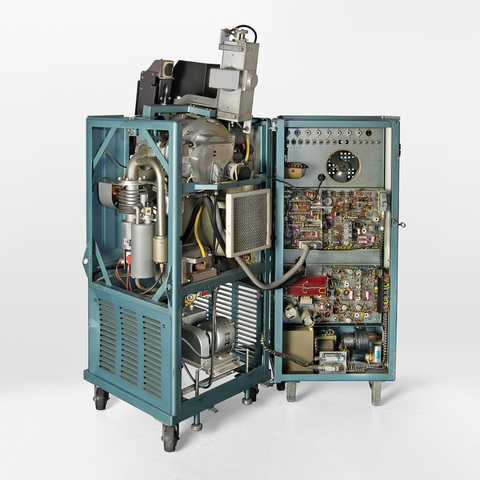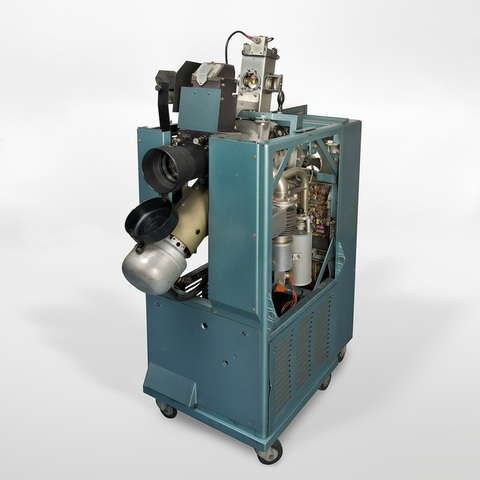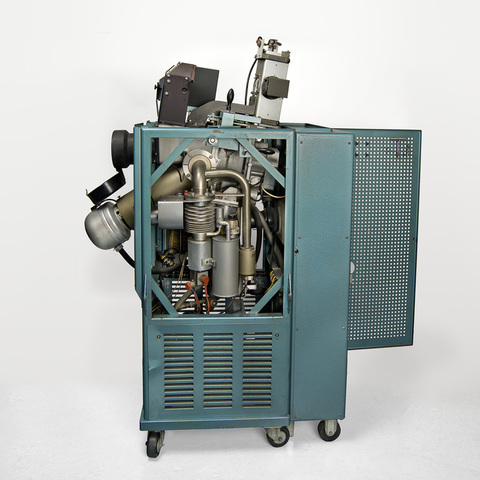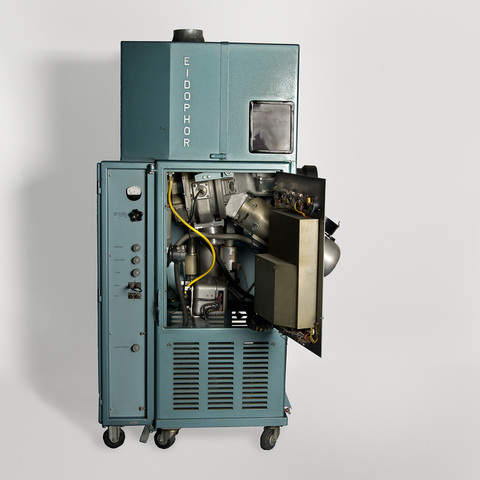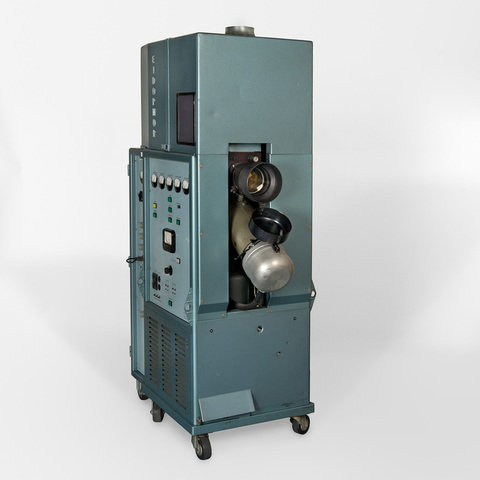Projecteur de télévision
Fiche détaillée
Type de l'appareil
projecteur d'images de télévision 325 lignes 4000 lumen ; cathode à faisceau électronique ; miroir sphérique à pellicule d'huile dans chambre à vide ; miroirs à grilles ; système de refroidissement à eau distillée ; objectif de projection ; lampe au xénon incorporée
Auteurs
Fischer Fritz
Zürich
Fabricants
Gretag
Regensdorf Zürich, Althardstrasse 70
Utilisateurs
Fischer Fritz
Zürich
Distributeurs
Gretag
Regensdorf Zürich, Althardstrasse 70
Twentieth Century Fox
Los Angeles
Sujet du modèle
Informations non disponibles
Objectif
Eidophor n° 4 101 012 F : 410 throw ratio 1 : 5,7
Taille de l'objet
Ouvert :
Longueur : 120 cm
Largeur : 70 cm
Hauteur : 202 cm
Fermé :
Informations non disponibles
Diamètre :
Informations non disponibles
Taille de la boîte de transport
Informations non disponibles
Remarques
Marque : "Eidophor n° 319 type ep 21 / BW Volts 190-235 Lines 235 Cycles 60 Kva 3 Gretag Regensdorf - Zürich Switzerland".
Procédé mis au point par le Dr Fritz Fischer (Suisse) en 1939, première démonstration publique le 31 décembre 1943.
"Le procédé Eidophor dont s'occupe la Twentieth Century Fox n'est pas du tout une invention américaine, mais suisse que la Fox a achetée et qu'elle expérimente. L'Eidophor combine un arc de projection avec le canon à électrons d'un tube cathodique de télévision, mais n'emploie pas l'écran fluorescent d'un tube cathodique. Le bombardement électronique, qui apporte l'information télévisée, est dirigé sur un liquide huileux de composition secrète. L'ionisation de ce liquide fait plisser sa surface. Ces plissements momentanés de la surface du liquide font dévier le faisceau lumineux de l'arc de projection, en l'obligeant à passer entre les interstices d'une grille qui, sans cette déviation, arrêteraient la lumière. De cette manière, la lumière arrive sur l'écran de projection et recrée l'image télévisée. Dans la mesure où le liquide n'est pas bombardé, la lumière provenant de la lampe à arc ne peut pas atteindre l'écran de cinéma car elle est arrêtée par les barres de la grille. En employant un disque portant des filtres colorés placés sur le trajet du faisceau lumineux, on a pu obtenir une image télévisée en couleurs. [...] Toutefois le système Eidophor est coûteux. Le liquide employé a une très faible tension de valeur, mais il est bombardé à la fois par un faisceau d'électrons et par la lumière d'une lampe à arc. Il s'ensuit qu'il doit s'évaporer dans une certaine mesure. La vapeur formée doit être éliminée et une pompe à vide constitue la partie essentielle de l'équipement. Il y a aussi un dispositif qui refroidit la plaque supportant le liquide, ceci permet d'employer une pompe à vide de petites dimensions" (La Technique cinématographique, n° 160, décembre 1955, p. 460-461).
"The Eidophor projector was invented by Prof. Fritz Fischer (1898-1947). Fischer was a brilliant scientist, whose profound knowledge earned him the promotion to engineer in charge of the Siemens-Halske central research laboratory in Berlin. Among other things, he worked on the development of remote-controlled battleships and airplanes and studied problems related to movie sound systems. One of his fellow researchers was Dr Edgar Gretener, the later founder of Gretag Ltd. These two Swiss engineers became very close friends. Before the outbreak of Wolrd War II, both decided to return to Switzerland rather than to contribute to the increasing German military effort. [...] Greitag moved all its activities to a newly-built plant in Regensdorf in spring 1962, and the Eidophor production was integrated into the company at its new location. This also meant bigger and better facilities which was very important because the 100th ep 2 projector was soon to be assembled and something new had to be conceived. A. Zeier returned from the United States and was put in charge of the Eidophor applications laboratory. He had carefully collected Eiodphor related information from different customers all over the world. All the experience gained with the ep 2 had to be incorporated into a new version. A 2500 W Xenon lamp had come onto the market and it had to be integrated in the new machine. Zeier was very successful in modernizing the ep 2, and by the end of 1962, production started on the ep 21. With the new lamphouse and the new 2500 Watt lamp, projection with 4000 lumen output was now reality. This meant that it was now possible to project onto a 100 square meter screen and still have a highlight brightness of 40 lux. The ep 21, incorporating vaulable input from users, was very easily to install, simple to operate and very reliable. As a matter of fact, NASA gave it a reliability rating exceeding 98 percent. Altogether 120 units of the Eidophor type ep 21 were manufactured and sold. The US Air Force showed interest in using Eidophor projectors in flight simulator applications" (Heinrich Johannes, The History of the Eidophor, Large Screen Television Projector, Regensdorf, Zurich, Gretag Aktiengesellschaft, 1989, p. 9 et 48).
Bibliographie
Heinrich Johannes, The History of the Eidophor, Large Screen Television Projector, Regensdorf, Zurich, Gretag Aktiengesellschaft, 1989.
René Bouillot, "La téléprojection, de l'Eidophore à la matrice DMD", Video Broadcast, octobre 1995, p. 80-87.
La Technique cinématographique, n° 160, décembre 1955, p. 460-461.
La Technique cinématographique, n° 266, septembre 1965, p. 48-49.
